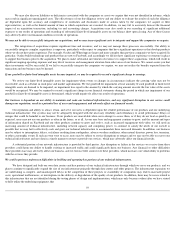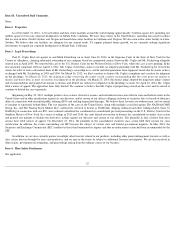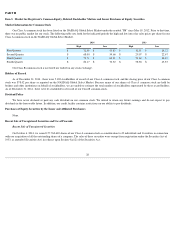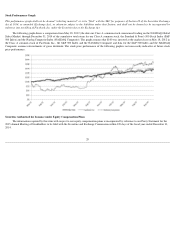Facebook 2014 Annual Report Download - page 23
Download and view the complete annual report
Please find page 23 of the 2014 Facebook annual report below. You can navigate through the pages in the report by either clicking on the pages listed below, or by using the keyword search tool below to find specific information within the annual report.
could further degrade the user experience or increase our costs.
Our products and internal systems rely on software that is highly technical, and if it contains undetected errors, our business could be adversely
affected.
Our products and internal systems rely on software, including software developed or maintained internally and/or by third parties, that is highly
technical and complex. In addition, our products and internal systems depend on the ability of such software to store, retrieve, process, and manage
immense amounts of data. The software on which we rely has contained, and may now or in the future contain, undetected errors, bugs, or
vulnerabilities. Some errors may only be discovered after the code has been released for external or internal use. Errors or other design defects within the
software on which we rely may result in a negative experience for users and marketers who use our products, delay product introductions or
enhancements, result in measurement or billing errors, or compromise our ability to protect the data of our users and/or our intellectual property. Any
errors, bugs, or defects discovered in the software on which we rely could result in damage to our reputation, loss of users, loss of revenue, or liability
for damages, any of which could adversely affect our business and financial results.
Certain of our user metrics are subject to inherent challenges in measurement, and real or perceived inaccuracies in such metrics may harm our
reputation and negatively affect our business.
The numbers for our key metrics, which include our DAUs, mobile DAUs, MAUs, mobile MAUs, and average revenue per user (ARPU), as well
as certain other metrics such as mobile-only DAUs and mobile-
only MAUs, are calculated using internal company data based on the activity of user
accounts. While these numbers are based on what we believe to be reasonable estimates of our user base for the applicable period of measurement, there
are inherent challenges in measuring usage of our products across large online and mobile populations around the world.
For example, there may be individuals who maintain one or more Facebook accounts in violation of our terms of service. We estimate, for
example, that "duplicate" accounts (an account that a user maintains in addition to his or her principal account) may have represented less than 5% of
our worldwide MAUs in 2014. We also seek to identify "false" accounts, which we divide into two categories: (1) user-
misclassified accounts, where
users have created personal profiles for a business, organization, or non-
human entity such as a pet (such entities are permitted on Facebook using a
Page rather than a personal profile under our terms of service); and (2) undesirable accounts, which represent user profiles that we determine are
intended to be used for purposes that violate our terms of service, such as spamming. In 2014, for example, we estimate that such user-
misclassified and
undesirable accounts may have represented less than 2% our worldwide MAUs. We believe the percentage of accounts that are duplicate or false is
meaningfully lower in developed markets such as the United States or United Kingdom and higher in developing markets such as India and Turkey.
However, these estimates are based on an internal review of a limited sample of accounts and we apply significant judgment in making this
determination, such as identifying names that appear to be fake or other behavior that appears inauthentic to the reviewers. As such, our estimation of
duplicate or false accounts may not accurately represent the actual number of such accounts. We are continually seeking to improve our ability to
identify duplicate or false accounts and estimate the total number of such accounts, and such estimates may change due to improvements or changes in
our methodology.
Our data limitations may affect our understanding of certain details of our business. For example, while user-
provided data indicates a decline in
usage among younger users, this age data is unreliable because a disproportionate number of our younger users register with an inaccurate age.
Accordingly, our understanding of usage by age group may not be complete.
Some of our metrics have also been affected by applications on certain mobile devices that automatically contact our servers for regular updates
with no user action involved, and this activity can cause our system to count the user associated with such a device as an active user on the day such
contact occurs. The impact of this automatic activity on our metrics varied by geography because mobile usage varies in different regions of the world.
In addition, our data regarding the geographic location of our users is estimated based on a number of factors, such as the user's IP address and self-
disclosed location. These factors may not always accurately reflect the user's actual location. For example, a mobile-
only user may appear to be
accessing Facebook from the location of the proxy server that the user connects to rather than from the user's actual location. The methodologies used to
measure user metrics may also be susceptible to algorithm or other technical errors. Our estimates for revenue by user location and revenue by user
device are also affected by these factors. We regularly review our processes for calculating these metrics, and from time to time we may discover
inaccuracies in our metrics or make adjustments to improve their accuracy, including adjustments that may result in the recalculation of our historical
metrics. We believe that any such inaccuracies or adjustments are immaterial unless otherwise stated. In addition, our DAU and MAU estimates will
differ from estimates published by third parties due to differences in methodology. For example, some third parties are not able to accurately measure
mobile users or do not count mobile users for certain user groups or at all in their analyses.
If marketers, developers, or investors do not perceive our user metrics to be accurate representations of our user base, or if we discover material
inaccuracies in our user metrics, our reputation may be harmed and marketers and developers may be less willing
20
























